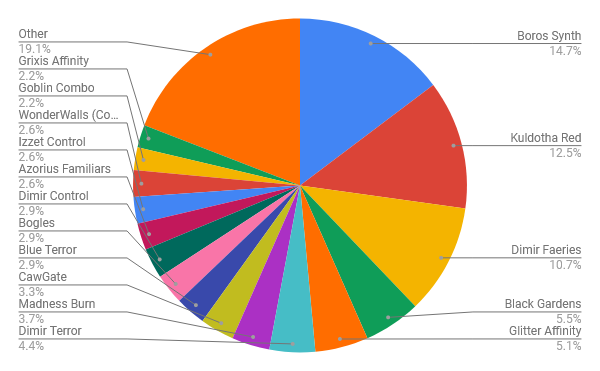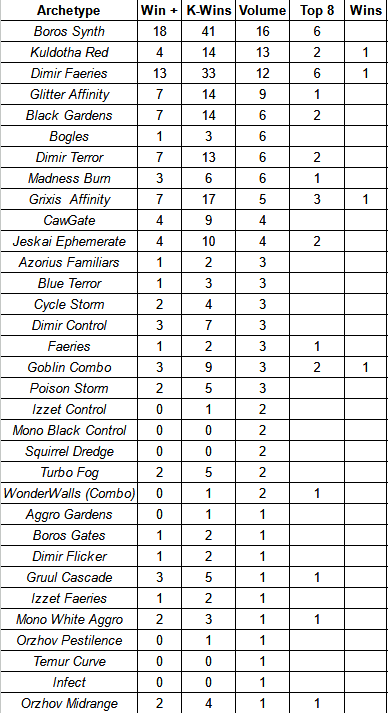Want to learn more about the metrics I use in tracking the metagame? You can find an explainer here.
Is a dynamic metagame – one where the best choices change from week to week – inherently healthy? Can a format be at its peak if things are static? This is one of the many questions being posed by Pauper at the moment. The impetus for this discourse is All That Glitters.
Let’s take a step backwards in time to before Monastery Swiftspear was banned. For the majority of the Swiftspear era in Pauper – that is the format between the Initiative Ban in September 2022 and the Swiftspear ban in December 2023 – red decks were a dominant force. While they may not have been the top performer every weekend they were by and large the consensus best deck. They not only defined the metagame but warped it around their presence.
I think now would be a good time to try and draw a line between defining a format and warping a metagame. These are not two discrete concepts but rather, in my estimation, exist on a spectrum. Flametongue Kavu defined its era of Standard by limiting the kind of creatures that could reasonably see play. Outside of curve based aggressive strategies, creatures had to have an immediate impact or have more than four toughness. You can see this pattern repeated in formats where Lightning Bolt is legal. Removal is not a perfect example as in larger card pools there are going to be a wide enough variety of spells that every creature will carry some liability. Various components come together to help define a metagame and format which help to provide a landscape, but the key here is that all of them help to establish parameters – it is not any one card or strategy that acts as a black hole, pulling everything towards its center.
Compare this to warping a format. In these situations the sheer force exerted by a strategy or card force it to the locus. At these times the offender is so powerful that the options are to either play it or play a deck that allegedly can smush it into the dirt. The Swiftspear era of Pauper was one where the confluence of cards that went into red made it such that you either ran Mountains or a build that was heavily skewed towards beating it. There have been times in Pauper’s past where the deck that was doing the warping was so powerful that ignoring it was a viable option, but you were doing so at your own peril.
So what does this all have to do with today? At the height of its power Kuldotha Red was the best deck week in and week out and it clearly defined the format and was warping things around its presence. Today, Glitter decks are one of the best decks in Pauper but have not consistently been at the top of the Weekend Challenge meta. There has been significant movement from one week to the next as to the top performer even if these decisions are made with All That Glitters in mind.

Above is the overall Challenge metagame summary from last weekend, including the newly added Friday Challenge. Here we see a shift from last weekend with Boros Synth (which for this season consists of decks that both include and eschew All That Glitters) taking over the top spot in popularity. The archetype also leads the way in Winner’s Metagame share with 16.07% and tops Adjusted Meta Score Above Replacement for the week with a score of 1.55. This comes after a three week sequence where the top decks for each weekend were Black Gardens, Dimir Faeries, and Dimir Control, all after an impressive run by Azorius Glitter Affinity.
Here is an example of a dynamic metagame. There are core strategies that exist and different focal points (some with more gravity than others) that all work to construct the cycle of the format. Now, more than during the Swiftspear era, making the correct deck choice from week to week matters, and having the correct suite of threats and answers can have a positive impact. We can see this play out in the fringe decks that rise up, having correctly anticipated the shifts in the meta and threading the needle. In this way Pauper is healthy.
Yet at the same time one element of the metagame seems to hold more weight, at least in the discourse around the format. All That Glitters exerts a unique pressure on Pauper in that it is a threat that must be respected at all times. Once you believe the opponent is on the Aura every game action needs to be taken with this knowledge and thus the preservation of your life total. To me this is not a situation where All That Glitters it the black hole that sucks everything towards it but it certainly has more mass than other celestial bodies.

So is Pauper healthy? It depends on your definition. If you care about the variety of viable archetypes and a metagame that rewards correctly anticipating the shifting tides, then Pauper is in the best place it has been since before Modern Horizons 2 hit the scene. If your view of a healthy format includes metagame cores that are all relatively equal in strength then this iteration of Pauper leaves something to be desired. Having a threat define the format is not bad per se but when it becomes so important that other decks are pulled into its orbit, then maybe something is amiss.
Is that where Pauper is currently? Well, that depends on who you ask. But for now I wouldn’t leave home without cheap removal and interaction for a resolved copy of All That Glitters.
I want to take a moment to thank all my Patrons I am going to do my level best to keep providing you with the kind of content that brought you here in the first place. If you are interested in supporting my work, rewards for my Patreon start at just $1.
Can’t make a commitment to Patreon? I have a Ko-Fi where you can make a one time contribution.
Looking for another way to support my work? Click here for my TCGPlayer affiliate link. Any purchases through the link let the folks there know you like my content!
